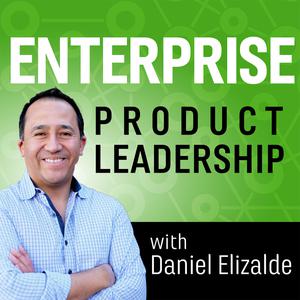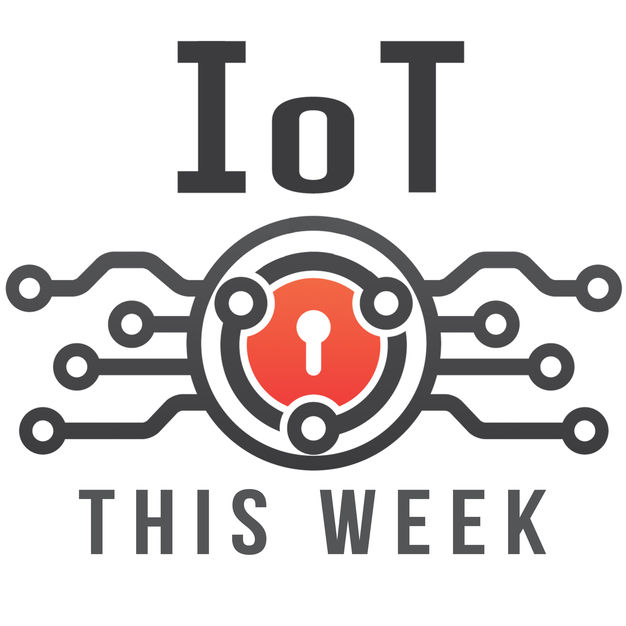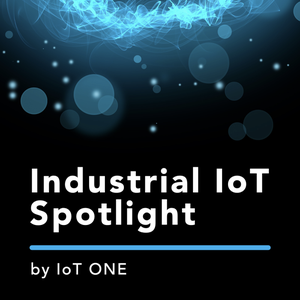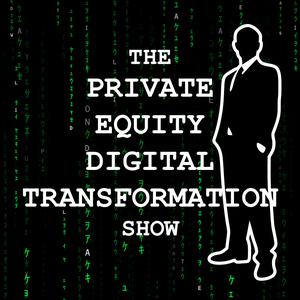
Enterprise Product Leadership
Daniel Elizalde
Welcome to the top podcast for B2B Product Leaders
- 34 minutes 43 seconds053: Cybersecurity for Industry 4.0: the good, the bad and the ugly, with Rob Dyson
In this episode of the Enterprise Product Leadership podcast, join me as I chat with Rob Dyson about the importance of cybersecurity in Industry 4.0.
Episode details: Cybersecurity in Industry 4.0: the Good, the Bad, and the Ugly, with Rob Dyson
I have a fascinating show for you today. My guest is Rob Dyson. Rob has decades of experience in the security space, and he is currently the Global OT and IoT Security Services Business Development Leader at IBM!
In this episode, Rob and I had a wide-ranging conversation about the impacts of cyber security in Industry 4.0 transformations, including:
- How cybersecurity can derail an Industry 4.0 transformation
- What is driving cybersecurity risks in Manufacturing
- How companies can create a culture of cybersecurity
- And much more
This is my second episode in collaboration with IBM, and it is an information-packed episode that no product leader should miss!
About Rob Dyson
With more than 30 years of experience in the Information Technology field, Rob Dyson has held technical and leadership positions while providing IT services for many companies within multiple industries. Rob is currently the Global OT/IoT Security Services Business Leader within IBM's Global Security Services practice. He is responsible for building, operating, and maturing our OT/IoT security business to help companies mitigate their OT & IoT cyber risks.
- Rob has experience gained from serving some of the largest global companies in multiple industries. He has served as the Client Executive for some of IBM's most strategic clients.
- Prior to this role, Rob served as the Global SSRC (Security, Strategy, Risk & Compliance) Competency Leader whereby he was responsible for developing unique and relevant solutions to assist clients in improving the effectiveness and efficiency of their information security program. This includes designing solutions to establish relevant information security strategies, comprehensive IT governance processes, redesigning security organizations, effective security policy management and governance processes, and compliance with leading security standards/frameworks and regulations. In addition, Rob has been at the forefront of delivering leading IT GRC solutions based on market-leading IT GRC applications such as OpenPages ITG, RSA Archer, and SAP GRC.
- Prior to joining IBM, Rob held senior leadership positions at Accenture as the Global Leader for Application & Infrastructure Security Services; at Deloitte as the Mid-America Region Leader for Security Services; at Electronic Data Systems (EDS) in positions of escalating responsibility providing IT professional services; and as an Officer in the U.S. Army where at the rank of Captain he was in charge of the 82nd Airborne Division Data Center Operations.
- Rob is an active CISSP and has a Bachelor of Science degree in Information Systems Management from Missouri State University in Springfield, Missouri.
To learn more about Rob Dyson and IBM's approach to cybersecurity in Industry 4.0
- Rob Dyson on LinkedIn
- IBM
- Monitor and secure industrial operations
- ABB and IBM Bolster cybersecurity for industrial operations
- Make cybersecurity a core element of your Industry 4.0 roadmap
- Learn how Industry 4.0 technologies are changing Manufacturing
- Get started with the visibility of your OT & IT assets
Want to learn more?
- Sign up for my newsletter at danielelizalde.com/join for weekly advice and best practices directly to your inbox!
- Visit danielelizalde.com/podcast for additional information, show notes, and all episodes.
- Subscribe on Apple Podcasts, so you don't miss out on any of my conversations with Product and Thought Leaders!
26 October 2021, 12:00 pm - 52 minutes 4 seconds052: Why Edge and AI hold the key to scaling Industry 4.0 with Jose Favilla
I have a fascinating show for you today that is part of my collaboration with IBM. My guest is Jose Favilla. Jose leads the global Industry 4.0 initiatives for IBM. And with over 30 years of experience in the field, Jose gives us a masterclass on Industry 4.0, including where it started, how it has evolved, where it is today, and where it is going
Tuning in, you'll hear the importance of edge and AI in driving the value of industry 4.0, how this technology enables companies to predict and prevent failures from occurring, and how companies can use the power of AI to improve the maintenance, quality, and efficiency of manufacturing plants significantly.
In this episode, Jose and I discuss:
- The importance of Edge and AI in driving the value of Industry 4.0
- How to scale your Industry 4.0 initiatives
- How to select the best vendor for your digital transformation
- And much more.
About Jose Favilla
Jose Favilla leads Industry 4.0 at IBM. His 30+ years of extensive experience working with clients in over 30 countries helps them improve operational and business performance. Jose has accumulated an in-depth understanding of the asset-intensive industries, including natural resources, processes, and discrete manufacturing.
Over his career, he has applied advanced analytics, optimization, AI, IoT, and Blockchain technologies to drive innovation. He has had the privilege of working with leading clients around the world to create new approaches and technologies to solve their complex business and operations problems.
Jose has been recognized as one of the top industry experts at IBM and was invited to be a member of the inaugural class of the IBM Industry Academy in 2011. Jose has chaired and spoken in numerous conferences around the world and published extensively and has won several awards in recognition of my achievements. He mentors new talents, MBA students at the leading US universities, and CEOs.
To learn more about Jose Favilla and IBM's Industry 4.0
- Jose's LinkedIn profile
- Learn about IBM's approach to Industry 4.0
- [Video] Manufacturers are using AI on a hybrid cloud with IBM
- [Interactive] Industry 4.0 scalability and flexibility
- [White paper] Industry 4.0
- [Article] How the convergence of OT and IT is driving Industry 4.0
- Additional case studies for Industry 4.0
Want to learn more?
- Sign up for my newsletter at DanielElizalde.com/Join for weekly advice and best practices directly to your inbox!
- Visit DanielElizalde.com/Podcast for additional information, show notes, and all episodes.
- Subscribe on Apple Podcasts, so you don't miss out on any of my conversations with Product and Thought Leaders!
5 October 2021, 12:00 pm - 37 minutes 25 seconds051: Product Innovation and Jobs to Be Done with Tony Ulwick
Today we are joined by the pioneer of the Jobs-to-be-Done (JTBD) theory, the inventor of the Outcome-Driven Innovation (ODI) process, and the founder of Strategyn, Tony Ulwick. When Tony was working as a manufacturing engineer for IBM in the 1980s, the company launched their PC Junior product. The colossal and expensive flop of this product led to Tony’s interest in product planning and the goal of his career to develop an innovation process that would prevent or mitigate the risk of failure. As someone who has become a world-renowned expert on innovation, today he joins us to discuss some of the problems companies face in their innovation initiatives. We talk about the challenges of understanding the needs of customers in a b2b context, how different methodologies such as Jobs-to-be-Done, Agile, Lean, and Design Thinking fit into the product life cycle, and the need for a unified innovation language across your company. Listen in to find out what the three most important things are that a company needs to be in alignment on, as well as Tony’s advice to anyone new to the Jobs-to-be-Done framework. This is an information-packed episode that no product leader should miss, so tune in today!
Links From Today’s Episode:
24 August 2021, 1:27 pm - 33 minutes 43 seconds050: How to price new B2B products with Mark Stiving
Pricing your products is key to successful products. But what is the best pathway to finding you optimum prices?
Mark Stiving returns to the show today to unpack his approach, which uses the concept of customer perceived value as the foundation of a price structure. This actionable conversation is sure to give you plenty of ideas for how to set your prices in order to suit your market and keep your business growing!
This actionable conversation is sure to give you plenty of ideas for how to set your prices in order to suit your market and keep your business growing! The last time we had Mark on the show, we talked about his book, Win Keep Grow, in which we got some clarity on subscription models for business, so if you missed that episode make sure to go back and check it out. Mark is a real authority on the subject of pricing, having worked in the space for almost 30 years now, and his insightful answers to today's questions will definitely make pricing seem less obscure and complicated.
Mark explains his approach of emphasizing value and using this as a guiding force for your prices, and he also goes into evaluating your customers' willingness to pay you, and the experiments you can run to gain more knowledge. We touch on the 'good, better, best' model, price increases, and much more, so make sure to joins us for this fantastic conversation!
Links From Today’s Episode:
10 August 2021, 12:00 pm - 38 minutes 45 seconds049: Continuous Discovery Habits with Teresa Torres
Today we are joined by expert discovery coach and prominent thought leader on the topic of product discovery, Teresa Torres!
Teresa is the author of the powerful new book, Continuous Discovery Habits, and in our conversation, we get to dig into some of the most impactful components of the book, as well as some great examples that showcase how the frameworks she espouses can work in real-life situations.
Teresa shares the discovery process she uses when working with clients, and we spend some time on the concepts of product trios and opportunity solutions trees, which are powerful ideas from Teresa's book. Our guest gives some great recommendations for how product leaders can get started with the project of continuous discovery and we also get to hear from her about what the new landscape of digital products requires from professionals in the field.
Links From Today’s Episode:
27 July 2021, 12:00 pm - 42 minutes 45 seconds048: Losant's Journey from Idea to Successful Enterprise IoT company with Charlie Key
Today’s guest, Charlie Key, is the Founder and CEO of Losant, a leading development platform for IoT products and services. On this episode, Charlie shares plenty of insights into how Losant has achieved success, including key milestones that have shaped the company, the importance of having a customer-centric approach to innovation, the challenges of building enterprise-grade products, and how Losant has evolved to incorporate technologies like edge computing to better serve their customers. He kicks off the episode by sharing a glimpse into his career journey, meeting his co-founders, and the inception of Losant. We touch on the ways in which the pandemic has changed all aspects of business, the importance of adapting with new data, and why Losant is always working on micro-pivots behind the scenes. Charlie reveals the three-part thesis that fueled the inception of Losant and the surprising results of customer research during the initial phases of the company. Next, we discuss how Charlie used the V2Mom model to build Losant: Vision, Values, Methods, Obstacles, and Measures. He tells us about the customer-centric approach he has taken to building his company and unpacks the process of selecting a target market, before talking about the value of including instrumentation in your research. We conclude our conversation with a few thoughts on emerging technologies, and how Losant has integrated them into their product offerings. We hope you tune in to hear from this expert in the field today.!
Links From Today’s Episode:
13 July 2021, 12:00 pm - 31 minutes 8 seconds047: Behind the scenes of Workday’s product strategy with Connie DeWitt
Today we get an amazing insider's look at how Workday, one of the most successful enterprise software companies in the world, approach product strategy! To help us in this quest, I am joined by Connie DeWitt, Senior Vice President of Product Strategy Workday. We have an illuminating conversation in which our guest shares a whole lot of wisdom and expertise about how she and her team have been so successful. Workday started as an enterprise HR solution and has grown at an incredible rate into a multi-billion dollar organization, expanding its product portfolio to Finance, HR, and planning solutions.
As most B2B leaders will know, this sort of scaling is extremely difficult to pull off, and their array of global products stands testament to the consistent and sustainable success they have achieved. Our guest gives us the low down on her approach to portfolio decisions, how the product teams are organized at Workday, and the unique way in which she and the company tackle the task of linking product management and product strategy. Join us today for an insightful conversation no Product Leader should miss!
Key Points From This Episode:
- Connie's current role at Workday, how she joined the company, and the services they provide.
- How Connie approached portfolio-wide decisions, what to invest in, and finding the best intersection of opportunity.
- The model that Workday uses to nurture products at different stages of their life cycles.
- The art and analytics of the decisions around which products need more investment.
- Connie's reflections on working at various sized companies and how the experiences compare.
- Measuring the ROI and the efficacy of product strategies; Workday's use of the RDI metric.
- How the product teams are organized at Workday and the product pillar structure of the company.
- The marriage of product strategy and product management; what sets Workday apart in its approach.
- Analytics and measurement and how Workday work to constantly improve and increase ROI.
- How to think about evaluating a team's ability to execute a strategy.
- The innovation cycle at Workday; Connie and her team's creation of a process for this.
- Connie's advice to product leaders and how to answer the two most important questions about product strategy!
Links From Today’s Episode:
29 June 2021, 12:00 pm - 46 minutes 54 seconds046: How Subscription Models Help You Win, Keep, and Grow Customers with Mark Stiving
Transitioning to a subscription model is not easy but the challenge is worth it because SaaS products provide a host of benefits to both the companies that offer them and the clients they serve. Our guest for today is Mark Stiving, author of Win Keep Grow, and he joins us to share important insights from his book to help us learn the fundamentals of accelerating a subscription business. Mark kicks things off with a story about how he got interested in prices, and then we go on an exploration of the connection between pricing and value. From there, Mark talks about how he began to study subscriptions, got fascinated by this model from a value perspective, and essentially combined his biggest aha moments into his new book. We go on a deep dive into some of the frameworks for understanding subscriptions Mark lays out in Win Keep Grow, looking firstly at how this model can be used to acquire and retain customers through renewals, but then also to expand through upgrades. We then get into the second framework which is all about how to take advantage of the expansion possibilities of subscriptions by using three different levers: market segments, pricing metrics, and packaging. In today’s conversation, listeners also get to hear Mark’s perspectives on the benefits and biggest challenges of transferring to a subscription model, before we wrap up with some top tips for companies looking to take the plunge. So for all this and more about how subscription models help you win, keep, and grow customers, tune in today!
Key Points From This Episode:
Introducing Mark, his education, and superpower of helping companies understand value.
Discussing the difficulty of pricing; toeing the line between seeming valuable versus arrogant.
Understanding the ‘acquisition, retention, expansion’ framework in Win Keep Grow.
Mark explains how the ‘three value levers’ framework in the book helps companies grow.
The ability that cloud companies have of using usage data to design tiered packages.
The use of the customer success department to SaaS companies and its functions.
Mark’s thoughts on why SaaS companies should be thinking about the benefits of their products.
Why subscription models benefit B2B companies: valuation, competition, and customer relations.
Challenges that companies face when transitioning to a subscription model.
Different models for compensating the sales team after transferring to a subscription model.
How companies can get better at getting their clients to not just renew but upgrade their subscriptions.
Using the ‘insurance company mentality’ when transferring to a subscription model.
Advice from Mark for product leaders considering transferring to a subscription model.
Links From Today’s Episode:
1 June 2021, 12:00 pm - 42 minutes 48 seconds045: Why Startups and Big Companies Struggle to Innovate with Steve Blank
The Lean Startup movement is integral to the foundation of modern entrepreneurship. Despite its proven success there are still many businesses, including both startups and established companies, that struggle to apply Lean principles and continue to build products through the waterfall approach. In today’s episode, we are joined by Steve Blank. In addition to being an author, entrepreneur, and professor, he is also widely recognized as an early father of the Lean Startup movement. In our discussion, Steve reflects on the current state of innovation in startups and enterprises and what can be done to improve it. Hear what it means to be an ambidextrous organization and why Steve holds it in such high regard. As we dive into the premise of Lean, Steve explains why on your first day as a startup, all you have is a series of untested hypotheses, whereas for an established organization the departure point is from a series of knowns. Later we discuss the concept of innovation theatre and why it’s more prevalent in established companies. Listeners can also expect to hear why the same processes for innovation that do well in startups, don’t work well for large organizations, largely because they are designed to minimize risk. Steve also shares examples of how the VP of sales can undermine innovation and why senior leadership in large organizations generally needs a lot of reform. We were honored to have Steve on the show and had a highly engaging and informative conversation that we know you’ll enjoy!
Key Points From This Episode:
Meet today’s guest Steve Blank.
The current state of innovation in startups and enterprises.
What it means to be an ambidextrous organization.
Every company needs to be able to execute and innovate concurrently.
Steve compares how the startup landscape has changed from when he started.
Why startups still tend to have a technology-first approach, rather than customer first.
The departure point for the premise of lean is that on your first day as a startup all you have is a series of untested hypotheses.
In an established organization the departure point is from a series of knowns, like your existing customer needs, your supply chain, etc.
Why founders are often too certain and why it’s a problem.
Finding a repeatable and scalable business model as a startup.
A discussion on the concept of innovation theatre.
Steve shares an anecdote explaining the ‘cargo cult’ to illustrate how large corporations misjudge what it means to have a lean approach.
Why large organizations can withstand innovation theatre for longer than a startup.
The same processes that do so well in startups for innovation don’t work for large organizations because they are designed to minimize risk.
Large organizations are not designed to innovate with speed and urgency.
With innovation, you want to take reasonable risks.
Why senior leadership needs to be reformed.
How the VP of sales can undermine innovation in a company.
When you have a disruptive innovation inside your own company you need to protect it from certain heads of department.
How Steve describes an innovation doctrine or an innovation pipeline and how to construct and adopt it.
Links From Today’s Episode:
18 May 2021, 12:00 pm - 24 minutes 45 seconds044: Behind the Scenes of Dolby’s new Cloud platform with Stephane Giraudie
What if developers could incorporate lifelike HD audio and video capability into any application they built so that users did not have to resort to third-party apps to communicate? This is precisely the service provided by Dolby’s new cloud-based audio, voice, and video API platform, Dolby.io. Today we speak to Stephane Giraudi, Senior Director of Cloud Communication at Dolby.io, to get a behind-the-scenes look at the audiovisual technology giant’s disruptive new offering. Stephane was previously the CEO of Voxeet, a company that enabled WebRTC with crystal clear 3D surround sound, audio, and video before Dolby acquired it. After the acquisition, the two firms joined forces and merged their strengths to produce Dolby.io. Our conversation starts with Stephane sketching out the services provided by Dolby.io and the new industries Dolby is penetrating as a result. From there, we talk about how enterprise firms can accelerate their roadmap by partnering with startups. Stephane shares his experiences joining Dolby and weighs in on challenges and lessons learned regarding finding common ground between startups and enterprise-scale firms' respective strengths and weaknesses. Wrapping up, we talk to Stephane about changing the monetization model at Dolby into a SaaS offering and hearing his approach to building products aimed at developers. Tune in today!
Key Points From This Episode:
Introducing Stephane and his career leading up to his position at Dolby.
The service Dolby.io provides; helping developers embed audiovisual communications in their apps.
New industries Dolby can tap with the services provided through Dolby.io.
How large companies can accelerate their roadmap by working with startups; Stephane’s experiences being acquired by Dolby.
The strategy and challenges involved with Dolby moving to a SaaS-based monetization model.
Lessons around how to acquire a company and integrate it into a broader firm.
Best practices for building products aimed at developers and their user experience.
Whether Dolby.io is optimizing its functionality for a certain class of apps.
Advice for corporations who want to partner with startups.
Links From Today’s Episode:
4 May 2021, 12:00 pm - 41 minutes 21 seconds043: Product Research Rules with C. Todd Lombardo
Getting to know your customer’s pains is one of the biggest challenges of building enterprise software. Joining me to take a deep dive into this topic is my good friend and return guest, C. Todd Lombardo.
As the VP of Product & Experience at Openly, an insurance-tech startup, C. Todd is a seasoned product leader in the B2B space with a ton of experience leading in-house product teams to success. He has also written two of my favorite product books: Product Roadmaps Relaunched: How to Set Direction while Embracing Uncertainty, and, of course, his newest book, Product Research Rules: Nine Foundational Rules for Product Teams to Run Accurate Research that Delivers Actionable Insight.
In this episode, C. Todd and I discuss topics based on three of the nine product rules included in his newest book, Product Research Rules: 1) How to align your team/s on the right question/s to research 2) How to plan research in a B2B context & 3) Why it is essential to share your findings throughout the innovation process.
Episode Details: Product Research Rules with C. Todd Lombardo:
“Start with the problem first; Don’t start with the solution or the technology.” — C. Todd Lombardo
About C. Todd Lombardo:
Data nerd. Design geek. Product Fanatic. Product-guy who believes “product” is not the right fit for today's data-driven, experiential world. C. Todd focuses on building and mentoring teams in areas of user experience design, product management, and product strategy. Currently, he is the VP of Product & Experience at Openly, an insurance-tech startup.
In addition to leading in-house product teams to success, C. Todd has worked as a design and product strategy consultant for notable clients such as TripAdvisor, LogMeIn, Spotify, New York Times, BBVA, FedEx, Lowes, and Genentech. Additionally, he serves on the adjunct faculty at Madrid's IE Business School and Baltimore's Maryland Institute College of Art (MICA), where he teaches graduate-level courses in design, innovation, and data visualization.
Topics We Discuss in this Episode:
- Todd’s career background and experience in various product roles
- About his newest book, Product Research Rules: Nine Foundational Rules for Product Teams to Run Accurate Research that Delivers Actionable Insight
- What you need to know to build a product that solves the problem(s) of your customers or users
- How to conduct research to fully understand what the problem is that you’re trying to address with the product you are creating
- What some of the key product rules are and how you can leverage them to drive you and your team forward
- Key insights and examples on “Rule #3: Good insights start with a question.”
- How to align your team as a leader so they can discover the right questions to ask and research (and get the executive team, management, and stakeholders on board too)
- Examples of how to create solutions for problems your customers are actually having
- Key insights and examples on “Rule #4: Plans make research work.”
- How to access/communicate with your customers in a B2B environment
- The critical role that the product leader plays in enabling their team to feel empowered
- Key insights and examples on “Rule #8: Insights are best shared”
- The importance of good user experience and a good product that fills a need and isn’t just a solution in search of a problem
Product Leader Tip of the Week:
When it comes to product research, you need to ask simple questions — then listen. The ability to ‘dig in’ and then know when to listen is crucial! Don’t wait to speak. Instead, listen to what somebody is saying and then respond.
And don’t forget: be humble if you’re wrong.
To Learn More About C. Todd Lombardo:
- Todd Lombardo’s LinkedIn
- Product Research Rules: Nine Foundational Rules for Product Teams to Run Accurate Research that Delivers Actionable Insight, by C. Todd Lombardo and Aras Bilgen
- Product Roadmaps Relaunched: How to Set Direction while Embracing Uncertainty, by C. Todd Lombardo, Bruce McCarthy, Evan Ryan, and Michael Connors
- Openly
Related Resources:
- Enterprise Product Leadership Episode 27: “How to Define a Clear IoT Vision” with C. Todd Lombardo
- danielelizalde.com/Template — Download Daniel’s free IoT Product Strategy Template here!
Want to Learn More?
- Sign up for my newsletter at danielelizalde.com/Join for weekly advice and best practices directly to your inbox!
- Visit danielelizalde.com/Podcast for additional information, show notes, and episodes.
- Subscribe on Apple Podcasts so you don’t miss out on any of my conversations with product and thought leaders!
20 April 2021, 12:00 pm - More Episodes? Get the App
Your feedback is valuable to us. Should you encounter any bugs, glitches, lack of functionality or other problems, please email us on [email protected] or join Moon.FM Telegram Group where you can talk directly to the dev team who are happy to answer any queries.
 IoT This Week
IoT This Week
 IoT Time Podcast
IoT Time Podcast
 The Internet of Things IoT Heroes show with Tom Raftery
The Internet of Things IoT Heroes show with Tom Raftery
 Industrial IoT Spotlight
Industrial IoT Spotlight
 IoT For All Podcast
IoT For All Podcast
 The Private Equity Digital Transformation Show
The Private Equity Digital Transformation Show